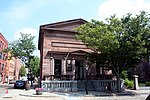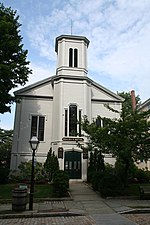Merrill's Wharf Historic District

The Merrill's Wharf Historic District is a historic district encompassing a portion of the waterfront area of New Bedford, Massachusetts. It encompasses two wharves just to the south of State Pier: the Steamboat Pier and the adjacent Coal Packet Pier. Also included is the stone counting house (also known as the Durant Sail Loft) built by Edward Merrill, the last surviving stone waterfront structure from New Bedford's heyday as a whaling center. (It does not include the long pier built by Merrill that is now called Homer's Wharf, which no longer retains historic integrity.)The district was listed on the National Register of Historic Places in 1977. It is now part of the New Bedford Whaling National Historical Park, with interpretive signs. The schooner Ernestina, a National Historic Landmark ship owned by the state, is berthed at Steamship Wharf.
Excerpt from the Wikipedia article Merrill's Wharf Historic District (License: CC BY-SA 3.0, Authors, Images).Merrill's Wharf Historic District
Macarthur Drive, New Bedford
Geographical coordinates (GPS) Address Nearby Places Show on map
Geographical coordinates (GPS)
| Latitude | Longitude |
|---|---|
| N 41.633055555556 ° | E -70.920833333333 ° |
Address
Macarthur Drive
02740 New Bedford
Massachusetts, United States
Open on Google Maps









